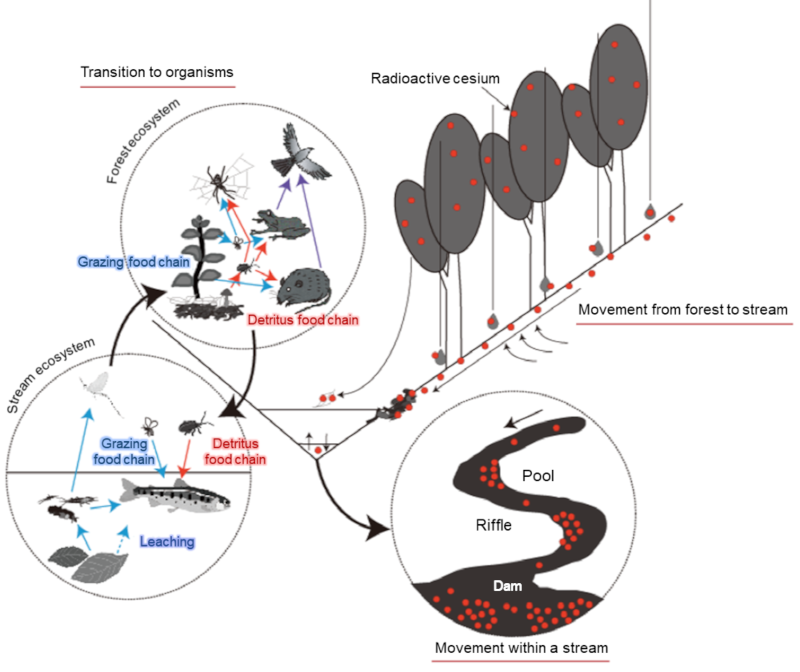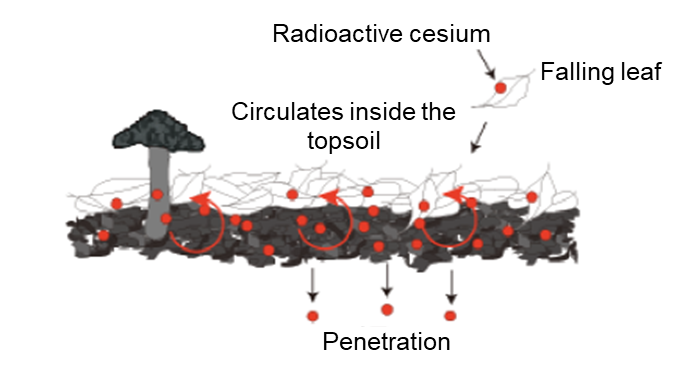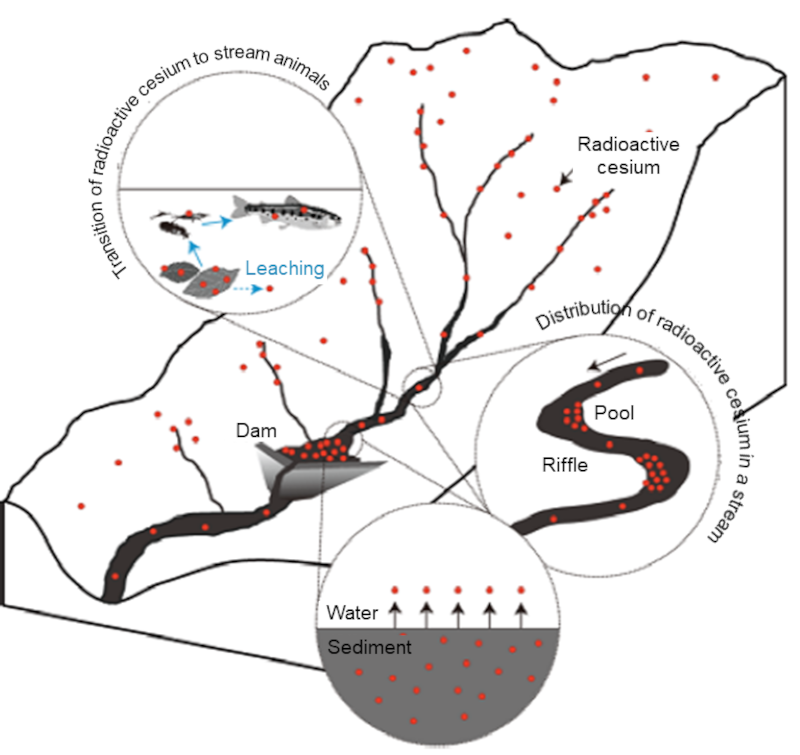Radioactivity Dynamics in forests
(2021)
QHow much do we know now about the movement of radioactive cesium in the forest-stream ecosystems?
AIn the topsoil of forests with various lifeforms residing, radioactive cesium circulates along with the circulation of nutrients among organism groups. Meanwhile, in pools and dams where water stagnates, radioactive cesium gathers after being moved by currents. In such places, radioactive cesium stays for a long period of time, while slowly migrating through movements of organisms, water, and soils. The key to reduce adverse effects of radioactive cesium on forest and stream products and on downstream regions in the future will be how to manage radioactive cesium gathered on the topsoil of forests and in stagnant waters.
A research team led by the National Institute for Environmental Studies and Tokyo University of Agriculture and Technology reviewed approximately 90 academic papers reported over the 10 years after the accident at the Fukushima Daiichi NPS to comprehensively investigate the movement of cesium in forests, the most major landscape feature of the contaminated region, and streams that run between the forests and the sphere of life of local residents.

Radioactive cesium released from the Fukushima Daiichi NPS broadly contaminated forests, farmlands, and residential areas around the NPS. In particular, forests are the most major landscape feature in the region contaminated by radioactive cesium. Among radioactive cesium released from the Fukushima Daiichi NPS, those in an ionized form (Cs+) tend to be taken into organisms relatively easily, and the cycles of them being taking into and released from animals and plants are continuing. When the accident occurred, trees in deciduous broadleaf forests had already shed their leaves and radioactive cesium directly fell onto the topsoil. Meanwhile, in evergreen coniferous forests, radioactive cesium deposited mainly onto the branches and leaves but gathered in the topsoil with time due to falling leaves, etc.

Fig. 1 Movement of radioactive cesium at the topsoil of forest
Radioactive cesium accumulated in the topsoil remains in the topsoil for a long period of time circulating in the forest, by being taken up through roots of plants or mycelia of fungi and circulating in the food chains due to feeding and excretion activities of animals. Also, some of radioactive cesium in the topsoil slowly moves down to soil layers deeper than the humus layer on the surface along with penetration of rainwater (Fig. 1). In general, it is rare for the radioactive cesium concentration in plants to exceed that in the humus, and the food chain that starts with the humus (detritus food chain) is considered to move more radioactive cesium than the food chain that starts with living plants (grazing food chain). By this circulation of radioactive cesium through the detritus food chain, some wild animals and forest products such as edible plants and mushrooms showed high radioactive cesium concentrations, sometimes even higher than the upper limit concentrations permitted for shipping under shipping restrictions imposed on the area.
Radioactive cesium that accumulated in forests migrates to streams along with rainfall and falling leaves. Streams that run through forests usually do not get much sunshine, and little periphyton is generated in the streams. Therefore, fallen leaves supplied from trees are the mainstay of the food chain. For that reason, animals feed on contaminated fallen leaves and predators feed on such animals, and thereby radioactive cesium gets taken up inside the bodies of various animals that live in the streams. However, due to leaching, the radioactive cesium concentration of fallen leaves that sunk in the streams was lower than that of leaves that fell onto the topsoil of forest (Fig. 2). This trend was more apparent immediately after contamination or in areas with a large amount of radioactive cesium fallout, and as a result the radioactive cesium concentration in animals at the top of the food chain was lower in streams than in forests. Now, 10 years after the NPS accident, branches and leaves to which radioactive cesium directly deposited have all fallen, and new branches and leaves with less radioactive cesium concentrations are falling. Considering that, this difference between forests and streams is expected to have become smaller. Meanwhile, deciduous broadleaf trees tend to absorb radioactive cesium from their roots easier than evergreen coniferous trees, and the radioactive cesium concentrations in leaves falling from them are likely higher than those in leaves falling from evergreen coniferous trees when compared within the same region.

Fig. 2 Movement of radioactive cesium in a stream
Radioactive cesium that entered a stream travels along the flow of water. For that reason, it has been a common understanding that radioactive cesium tends to accumulate at sections with slower water flow (Fig. 2). For example, a report has been made on a comparison of radioactive cesium concentrations in the same types of insects that live in a pool and in a riffle. The results saw the former being higher than the latter, demonstrating that more radioactive cesium accumulates in pools where water flows slower than in riffles where water flows faster. Also, a lot of radioactive cesium accumulates in stream sections where the water flow suddenly become slow, such as a dam. Such places function as a reservoir for radioactive cesium, but some of the accumulated radioactive cesium leaches out of bottom sediments and flows downstream (Fig. 2). Like that, sections with slower water flow are concerned to gather radioactive cesium and gradually feed it to the downstream area.
As such, it has become known that, in the forest-stream ecosystems, the topsoil of forest and stream sections with slower flow of water in particular accumulate radioactive cesium, and they serve as reservoirs as well as sources of supply of radioactive cesium. It is a given that radioactive cesium continues to transfer from such places to animals and plants that live in the area for a long period of time. Therefore, how to manage such radioactive cesium is considered to be important in reducing contamination of forest and stream products.
Recently, some researchers have been investigating how to prevent transfer of radioactive cesium accumulated in the topsoil of forests to useful plants such as edible wild plants. Example measures include decontamination by removing the topsoil itself, mixing potassium (which has similar chemical properties as cesium) in as a fertilizer, and addition of clay minerals that strongly adsorb radioactive cesium. These measures require validation, as well as evaluation of the impacts of such artificial modification of the environment on the forest ecosystem. After all, it is preferable to reduce contamination of forest products without damaging the original functionality of the ecosystem.
For the stream ecosystem, researchers are studying the dynamics of radioactive cesium in streams as in how much of radioactive cesium accumulated in a dam leaches out and how that contributes to the contamination of aquatic organisms and spreading of radioactive cesium downstream. Future studies may include management methods for suppressing the amount of radioactive cesium leaching out (e.g., dredging) based on the findings from these studies on the environmental dynamics of radioactive cesium.
Over 400 NPSs are operating all over the Earth, and nuclear energy is anticipated to be one of the measures utilized to address the climate crisis. However, the accident at the Fukushima Daiichi NPS clearly showed us the difficulty of contamination management once the environment is subjected to radioactive contamination. Researchers need to continue to elucidate the environmental dynamics of radioactive cesium, while trying to find how to manage places where radioactive cesium tends to accumulate. Findings obtained by such studies must be shared with various stakeholders to build collaborative relationships toward true recovery from the accident.
(Research results from the National Institute for Environmental Studies and others. Reproduced from the website of the National Institute for Environmental Studies (partly edited by JAEA)
Related articles
- Is radioactive cesium in forests dispersed by wind? 【Near forests】
- Is radioactive cesium in forests dispersed by wind? 【Airy places】
- Will radioactive contamination continue to accumulate in reservoirs due to the inflow of radioactive cesium from rivers? 【Tendency of the change of the concentration in reservoir beds】
- Will radioactive contamination continue to accumulate in reservoirs due to the inflow of radioactive cesium from rivers? 【Effect of the upstream dam on 137Cs accumulation in the riservoir beds】
- How much does additional internal dose exposure would be if we assume highest concentration during the fire event was exposed? How harmful for the health?
